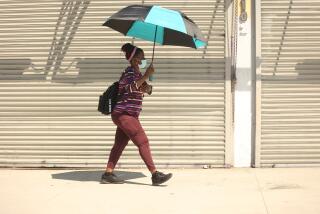Deadly July Heat Is Taken as a Warning
- Share via
During last month’s deadly heat wave, the cramped Fresno County coroner’s office stacked bodies on top of one another.
Local hospitals were so swamped with patients suffering heat-related illnesses that they ran out of gurneys. And ambulances responded to a record number of heat emergencies.
Other Central Valley counties experienced similar problems during July’s series of 100-degree-plus days. As a result, officials worry that they are ill-prepared to deal with a possible pandemic flu outbreak or other major regional disaster.
“We could have up to 1,000 deaths in a wave of pandemic flu,” said Edward Moreno, public health officer for Fresno County, where 28 people died as a result of the heat. “A lot more people will be impacted, and whether or not we’re prepared for that, well, we’re still working on that.”
To prepare for the next crisis, California counties are counting on $214 million in new state money earmarked for disaster preparedness. Most of it will go toward preparations for a potential pandemic flu outbreak and to expand emergency hospital bed space. Of that money, $18.3 million will be set aside to equip and manage three mobile field hospitals that could be deployed in a major disaster.
The Governor’s Office of Emergency Services and the California Health and Human Services Agency convened a task force of state and local health officials last week to expand response efforts in anticipation of the next significant heat wave.
Officials said some cooling centers for seniors, the disabled and other vulnerable populations were underused last month, in part because of a lack of transportation. They also want to do a better job of letting people know what services and relief programs are available.
Kim Belshe, secretary of the Health and Human Services Agency, noted the use of Department of Transportation signs for messages about energy conservation. “We also need to be flashing messages about public health and safety.”
The task force plans to meet regularly to coordinate services and develop health and safety protocols for outreach efforts, evacuation of medical facilities, safety checks for seniors and establishment of cooling centers.
Last month’s heat wave was responsible for 106 confirmed heat-related deaths in California, with 35 suspected cases still under investigation, according to state officials. The Central Valley was among the areas hardest hit, with Fresno County reporting 28 confirmed heat-related deaths and Stanislaus County 19, with five cases pending.
On one sizzling July weekend, the University Medical Center and Fresno Community Hospital combined treated more than 60 patients for heat-related illnesses, officials said.
“We really were just inundated,” said Gerald Harder, University Medical Center’s emergency services coordinator, who has worked there since 1994. “I’ve never seen anything like this.”
On another day, University Medical Center shut its doors to all except trauma and burn patients for two hours. It was the hospital’s first diversion in more than four years, said Mary Lisa Russell, a hospital spokeswoman.
“We just couldn’t take any more people,” she said.
Stanislaus County wrestled with its own problems. Its 28-year-old morgue was “pushed to its limits,” said David Jones, spokesman for the county’s Office of Emergency Services.
“This was an unprecedented disaster that put incredible stress on many parts of the emergency system,” Jones said. “The question will be raised of whether you need to rebuild the entire system.”
Dr. John Walker, the county’s health officer, said the heat emergency underscored the need to be better prepared for a crisis.
He said firefighters scrambled to keep the air conditioners running at nursing homes to prevent more elderly from falling ill and flooding hospitals.
“What I was most worried about was the hospitals being overwhelmed by evacuees from long-term care facilities,” Walker said. “If you move the patients out, how do you staff the other facility? How do you handle doctors’ orders?”
County officials plan to meet this month to review the emergency response program and hope to identify some specific areas for improvement, including expansion of the county morgue.
Although Tulare County reported only one heat-related death, Public Health Officer Ray Bullick said the need for better preparation should serve as a warning for all Central Valley communities.
“It was a good opportunity to see first-hand where we’re really needing to shore up our emergency response,” he said.
“We are well-served in developing clear emergency policies and procedures. That’s what I’m most uncomfortable with right now.”
Added Laura Segal, spokeswoman for the Trust For America’s Health, a nonprofit watchdog group: “The heat wave was consistent with our findings in a lot of states regarding hospital preparedness. If there was a pandemic flu or bioterrorism attack, you can imagine that kind of tragedy could be amplified exponentially.”
More to Read
Sign up for Essential California
The most important California stories and recommendations in your inbox every morning.
You may occasionally receive promotional content from the Los Angeles Times.













